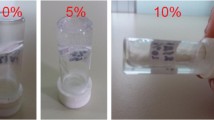Abstract
Molecular dynamics simulations are used to study the effect of polyisobutylene polymer on the viscosity of polyalphaolefin base oil. The Newtonian viscosities of the solution calculated from simulations at 40 and 100 °C agree with rheometer measurements. The simulations are used to investigate three possible mechanisms by which the polymer may increase solution viscosity. The results indicate that neither (1) coil expansion nor (2) polymer–polymer association underlie viscosity enhancement in the case studied here. Measurements of solvent reorientation close to the additive molecule suggest that (3) modification of the solvent by the additive molecule contributes to viscosity enhancement.








Similar content being viewed by others
References
Canter, N.: Viscosity index improvers. Tribol. Lubr. Technol. 67(9), 10–22 (2011)
Ghosh, P., Das, M.: Study of the influence of some polymeric additives as viscosity index improvers and pour point depressants synthesis and characterization. J. Pet. Sci. Eng. 119, 79–84 (2014)
Nassar, A.M.: Synthesis and evaluation of viscosity index improvers and pour point depressant for lube oil. Pet. Sci. Technol. 26(8), 523–531 (2008)
Stöhr, T., Eisenberg, B., Müller, M.: A new generation of high performance viscosity modifiers based on comb polymers. SAE Int. J. Fuels Lubr. 1(1), 1511–1516 (2008)
Selby, T.W.: The non-newtonian characteristics of lubricating oils. ASLE Trans. 1(1), 68–81 (1958)
de Gennes, P.G.: Reptation of a polymer chain in the presence of fixed obstacles. J. Chem. Phys. 55(2), 572–579 (1971)
Ferry, J.D.: Viscoelastic properties of polymer solutions. J. Res. Natl. Bur. Stand. 41(1), 53–61 (1948)
Schulz, D.N., Glass, J.E.: Polymers as Rheology Modifiers. American Chemical Society, Washington, DC (1991)
Longworth, R., Morawetz, H.: Polymer association. IV. Hydrogen bonding and melt viscosities in copolymers of styrene with methacrylic acid. J. Polym. Sci. 29(119), 307–319 (1958)
Yekta, A., Xu, B., Duhamel, J., Adiwidjaja, H., Winnik, M.A.: Fluorescence studies of associating polymers in water: determination of the chain end aggregation number and a model for the association process. Macromolecules 28(4), 956–966 (1995)
Rouse Jr., P.E.: A theory of the linear viscoelastic properties of dilute solutions of coiling polymers. J. Chem. Phys. 21(7), 1272–1280 (1953)
Plimpton, S.: Fast parallel algorithms for short-range molecular dynamics. J. Comput. Phys. 117(1), 1–19 (1995)
Jorgensen, W.L., Maxwell, D.S., Tirado-Rives, J.: Development and testing of the OPLS all-atom force field on conformational energetics and properties of organic liquids. J. Am. Chem. Soc. 118(45), 11225–11236 (1996)
Siu, S.W.I., Pluhackova, K., Böckmann, R.A.: Optimization of the OPLS-AA force field for long hydrocarbons. J. Chem. Theory Comput. 8(4), 1459–1470 (2012)
Ye, X., Cui, S., de Almeida, Valmor F., Khomami, B., Khomami, B.: Effect of varying the 1–4 intramolecular scaling factor in atomistic simulations of long-chain n-alkanes with the OPLS-AA model. J. Mol. Model. 19(3), 1251–1258 (2013)
Nosé, S.: A molecular dynamics method for simulations in the canonical ensemble. Mol. Phys. 52(2), 255–268 (1984)
Hoover, W.G.: Canonical dynamics: equilibrium phase-space distributions. Phys. Rev. A 31, 1695–1697 (1985)
Kelkar, M.S., Rafferty, J.L., Maginn, E.J., Siepmann, J.I.: Prediction of viscosities and vapor–liquid equilibria for five polyhydric alcohols by molecular simulation. Fluid Phase Equilib. 260, 218–231 (2007)
Müller-Plathe, F.: Reversing the perturbation in nonequilibrium molecular dynamics: an easy way to calculate the shear viscosity of fluids. Phys. Rev. E 59, 4894–4898 (1999)
Tenney, C.M., Maginn, E.J.: Limitations and recommendations for the calculation of shear viscosity using reverse nonequilibrium molecular dynamics. J. Chem. Phys. 132(1), 014103 (2010)
Ramasamy, U.S., Len, M., Martini, A.: Correlating molecular structure to the behavior of linear styrene–butadiene viscosity modifiers. Tribol. Lett. 65(4), 147 (2017)
Bhattacharya, P., Ramasamy, U.S., Krueger, S., Robinson, J.W., Tarasevich, B.J., Martini, A., Cosimbescu, L.: Trends in thermoresponsive behavior of lipophilic polymers. Ind. Eng. Chem. Res. 55(51), 12983–12990 (2016)
Covitch, M.J., Trickett, K.J.: How polymers behave as viscosity index improvers in lubricating oils. Adv. Chem. Eng. Sci. 5(2), 134–151 (2015)
Ramasamy, U.S., Lichter, S., Martini, A.: Effect of molecular-scale features on the polymer coil size of model viscosity index improvers. Tribol. Lett. 62(23), 1–7 (2016)
Jacobs, T.B.D., Martini, A.: Measuring and understanding contact area at the nanoscale: a review. Appl. Mech. Rev. 69, 061101 (2017)
Allen, W., Rowley, R.L.: Predicting the viscosity of alkanes using nonequilibrium molecular dynamics: evaluation of intermolecular potential models. J. Chem. Phys. 106(24), 10273–10281 (1997)
Ewen, J.P., Gattinoni, C., Thakkar, F.M., Morgan, N., Spikes, H.A., Dini, D.: A comparison of classical force-fields for molecular dynamics simulations of lubricants. Materials 9(8), 651 (2016)
Cusseau, P., Bouscharain, N., Martinie, L., Philippon, D., Vergne, P., Briand, F.: Rheological considerations on polymer-based engine lubricants: viscosity index improvers versus thickeners—generalized Newtonian models. Tribol. Trans. (2017). https://doi.org/10.1080/10402004.2017.1346154
Singh, H., Gulati, I.B.: Influence of base oil refining on the performance of viscosity index improvers. Wear 118(1), 33–56 (1987)
Flory, P.J.: Principles of Polymer Chemistry. Cornell University Press, Ithaca (1953)
Grosberg, A.Y., Kuznetsov, D.V.: Quantitative theory of the globule-to-coil transition. 1. Link density distribution in a globule and its radius of gyration. Macromolecules 25(7), 1970–1979 (1992)
Mazur, J., McIntyre, D.: The determination of chain statistical parameters by light scattering measurements. Macromolecules 8(4), 464–476 (1975)
Mary, C., Phillipon, D., Lafarge, L., Laurent, D., Rondelez, F., Bair, S., Vergne, P.: New insight into the relationship between molecular effects and the rheological behavior of polymer-thickened lubricants under high pressure. Tribol. Lett. 52, 357–369 (2013)
Acknowledgements
We thank David Gray, Joan Souchik and Paul Michael for useful discussion and feedback related to viscosity modifiers. We also acknowledge the Donors of the American Chemical Society Petroleum Research Fund (Grant #55026-ND6), National Science Foundation Engineering Research Center for Compact and Efficient Fluid Power EEC 05440834, and the National Fluid Power Association Education and Technology Foundations Pascal Society for support of this research.
Author information
Authors and Affiliations
Corresponding author
Rights and permissions
About this article
Cite this article
Len, M., Ramasamy, U.S., Lichter, S. et al. Thickening Mechanisms of Polyisobutylene in Polyalphaolefin. Tribol Lett 66, 5 (2018). https://doi.org/10.1007/s11249-017-0960-3
Received:
Accepted:
Published:
DOI: https://doi.org/10.1007/s11249-017-0960-3




